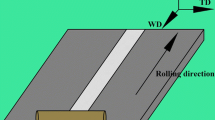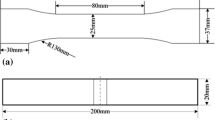Abstract
Friction stir welding (FSW possesses more advantages than other traditional welding processes because it is a solid-state joint process [1]. In addition, friction stir processing is adopted as a new surface modification approach. It is acceptable that the dynamic recrystallization phenomenon during FSW/FSP results in the generation of fine and equiaxed grains in the stir zone [2–3].
Access this chapter
Tax calculation will be finalised at checkout
Purchases are for personal use only
Preview
Unable to display preview. Download preview PDF.
Similar content being viewed by others
References
M.W. Mahoney, CG. Rhodes, J.G. Flintoff, R.A. Spurling, and W.H. Bingel, “Properties of Friction-stur-welded 7075 T651 Aluminum,” Metallurgical and Materials Transactions A, 29A (1998), 1955–1964.
B. London, M. Mahoney, B. Bingel, M. Calabrese, and D. Waldron, “Investigations on Residual Stresses in Friction Stir Welds” (Paper presented the 3th International Symposium on Friction Stir Welding, Kobe, Japan, 27 September 2001),27–28.
T.U. Seidel and A.P. Reynolds, “Visualization of material flow in AA2195 friction-stir welds using a marker insert technique,” Metallurgical and Materials Transactions A, 32A (2001), 2879–2884.
W. Woo, H. Choo, D.W. Brown, P.K. Liaw, and Z. Feng, “Texture variation and its influence on the tensile behavior of a friction-stir processed magnesium alloy,” Scripta Materialia, 54 (2006), 1859–1864.
H. W. Lee, T. S. Lui, and L. H. Chen, “Studies on the improvement of tensile ductility of hot-extrusion AZ31 alloy by subsequent friction stir process,” Journal of Alloys and Compounds, 475 (2009), 139–144.
C. J. Lee, J. C. Huang, and X. H. Du, “Using Multiple FSP Passes to Cure Onion Splitting of Mg Alloys Deformed at Elevated Temperatures,” Materials Transactions, 48 (4) (2007), 780–786.
S.M. Fatemi-Varzaneh, A. Zarei-Hanzaki, and H. Beladi, “Dynamic recrystalhzation in AZ31 magnesium alloy,” Materials Science and Engineering A, 456 (2007), 52–57.
H.J. McQueena, and C.A.C. Imbert, “Dynamic recrystalhzation: plasticity enhancing structural development,” Journal of Alloys and Compounds, 378 (2004), 35–43.
Author information
Authors and Affiliations
Editor information
Editors and Affiliations
Rights and permissions
Copyright information
© 2012 TMS (The Minerals, Metals & Materials Society)
About this chapter
Cite this chapter
Chen, HC., Lui, TS., Chen, LH., Hung, FY. (2012). Effects of Friction Stir Process on the Tensile Properties of AZ61 Magnesium Alloy at Room Temperature to 200 °C. In: Mathaudhu, S.N., Sillekens, W.H., Neelameggham, N.R., Hort, N. (eds) Magnesium Technology 2012. Springer, Cham. https://doi.org/10.1007/978-3-319-48203-3_93
Download citation
DOI: https://doi.org/10.1007/978-3-319-48203-3_93
Publisher Name: Springer, Cham
Print ISBN: 978-3-319-48571-3
Online ISBN: 978-3-319-48203-3
eBook Packages: Chemistry and Materials ScienceChemistry and Material Science (R0)




